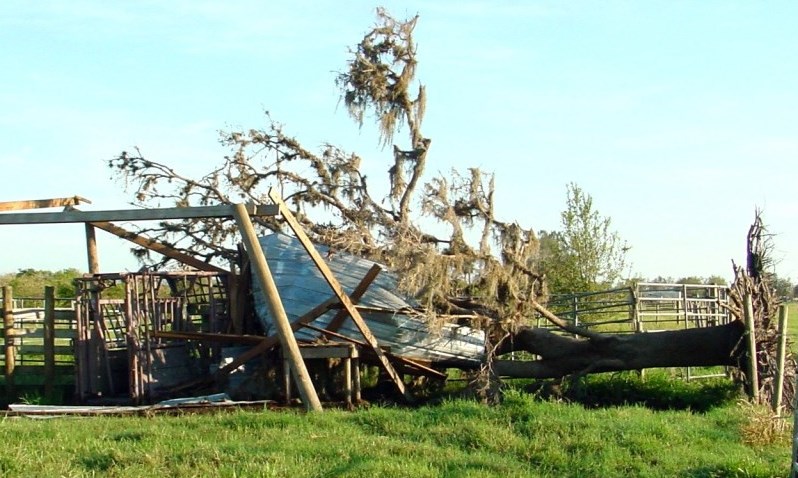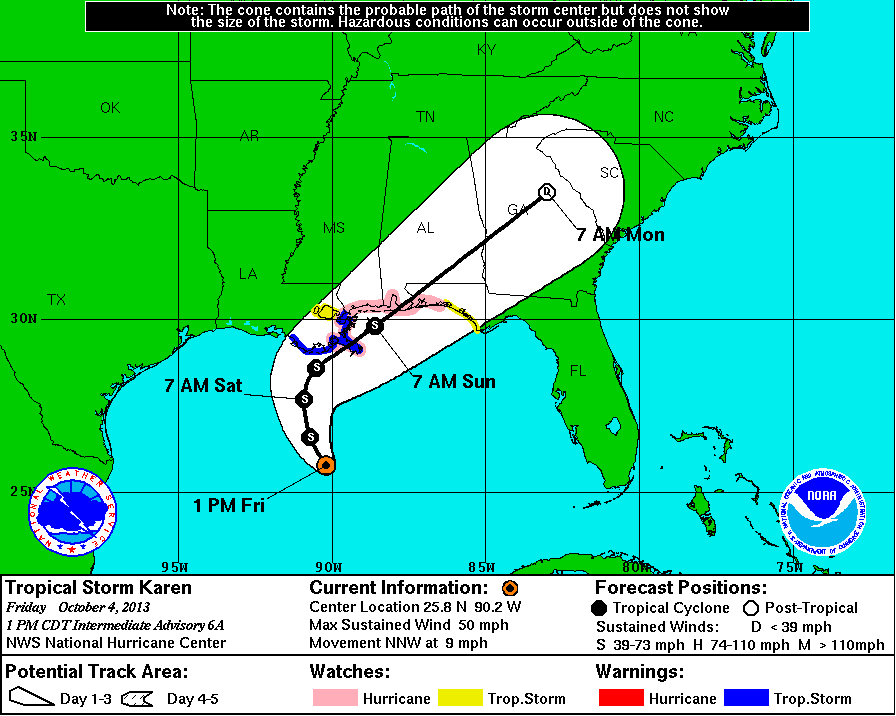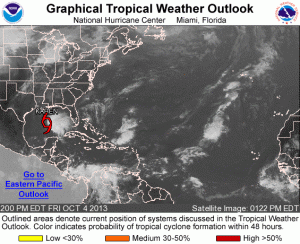According to the latest National Weather Service update at 2pm EDT,
Tropical Storm Karen was located about 240 miles south of the mouth of the Mississippi River moving north northwest at 9 miles per hour.
By the time you read this, the location and direction will have changed. More importantly, a tropical storm does not have to make landfall in your county or your state to create destruction and danger to life and property. Even after landfall,wind,rain and tornadoes may occur. Good information can be hard to find in the confusion.
The latest information on the status of the storm and Florida Division of Emergency Management information on the impact of the storm can be found at http://www.nhc.noaa.gov/ and
http://www.floridadisaster.org/index.asp
Be informed, be prepared, and be careful!
 Tropical Storm Preparation Tips
Tropical Storm Preparation Tips
While Tropical Storm Karen may not pack the punch of past major hurricanes, there are some things to think about as you prepare your farm for Sunday’s storm. At the very least, Karen will bring rain and wind to the Panhandle. There is always the possibility of violent thunderstorms and tornadoes, but the most probable impact may be power outages. While this storm is not predicted to cause massive damage, there are some preparations that should be made.
Loss of Power
In rural areas, power may not be restored for several days. This can cause some real problems, so here are some things to consider.
- Move animals to pastures with ponds so well filled water troughs are not the only source of water.
- Dairy farms should have enough generator power so that cows can be milked each day. Give them a test run to make sure they are in good operating condition.
- Stock up on things purchased regularly from farm supply dealers: feed, hay, hydraulic oil, diesel fuel, etc. These stores may not been open for a few days, if power is lost to an area.
- Fill trucks, tractors, four wheelers, and other equipment with fuel, so they are ready to work in an emergency.
- Make sure chainsaws run and stock up on mixed fuel and bar oil, in case trees need to be trimmed off fences or buildings.
High Winds
Barns and fences are very susceptible to fallen trees and limbs from even tropical storm force winds. Tornadoes are also common in rural areas as storms move through.
- Move animals and valuable equipment out of barns. Most agricultural barns are not made to withstand more than 60 mile per hour winds with out some damage. Metal roofing material falling and flying around can be deadly. Normally open fields or pastures are much safer for both animals and equipment. Animals out in the open have a way of avoiding danger most of the time.
- Move animals to interior pastures so there are multiple fences between animals and the highway or neighbors.
- Small trees and large limbs will create holes in fences when they fall. Have chainsaws and fencing supplies ready to go to clean up perimeter fences following a storm.
- Pick up debris that might become high-wind hazards. Strap down feeders, trailers and other items that might blow around and injure animals or cause damage to facilities.
Flooding
Tropical storms can generate 3-10 inches of rain as they pass through.
- Move animals out of low lying pastures or at least tie the gates open so they can move to higher ground if need be.
- Move tractors, equipment, portable tanks, etc. to high ground.
Clean up and Repairs
Notification and documentation are the keys to getting financial aide following a storm.
- Contact insurance agencies as soon as possible for buildings that are insured.
- Report any damages to the local Farm Service Agency within 15 days of the storm to be eligible for federal disaster aide.
- Document damage and repair expenses. Photographs of damages and receipts for services and materials will be very important when applying for insurance claims and federal disaster aide. Any purchased feed or veterinary expenses related to the storm should be recorded as well.


